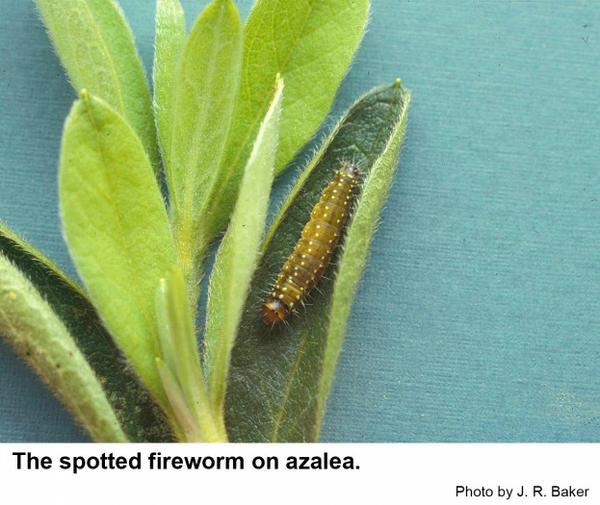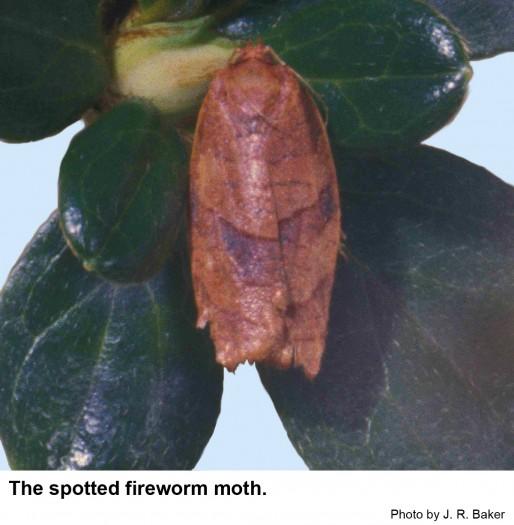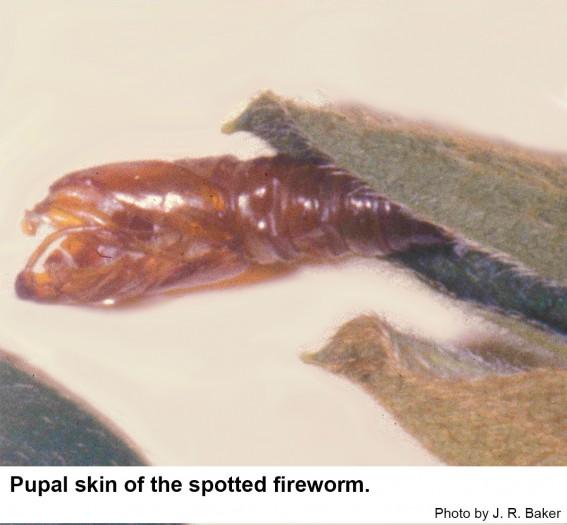Biology
Not much is known about the life history of the spotted fireworm, Choristoneura parallela, in North Carolina. The closely related obliquebanded leafroller has two generations per year. Since spotted fireworm moths have been collected from April until October, it is likely they also have at least two generations per year. Obliquebanded leafrollers are noteworthy because they overwinter as tiny caterpillars in a very small cocoon on the bark. This kind of cocoon is called a hibernaculum. These caterpillars emerge in the spring and feed on the tender new growth. Spotted fireworms are also leafrollers, that is, they roll the leaves up and reside within when not feeding. At maturity, the caterpillars pupate within the rolled up leaf. Sometime afterward new moths emerge. Female moths secrete a pheromone that helps males find them. After mating, females lay eggs on various kinds of trees, shrubs and flowers.
Host Plants
Spotted fireworms infested a large number of ornamental plants where they roll up leaves from which they emerge to feed on nearby foliage. Spotted fireworms have been collected from almond, azalea, blueberries, citrus, cranberry, gardenia, goldenrod, roses, and sheep laurel.
Residential Recommendation
It is difficult to get an insecticide into the rolled up leaves to kill the worms. However, spotted fireworms are not reputed to be resistant to insecticides, so infested plants can be treated with pyrethroids to control the spotted fireworms as they come out of their leaf rolls to feed. When used as directed, pyrethroids are very toxic to insects but are not particularly hazardous to humans and pets (other than fish-avoid using pyrethroids around pools, ponds, and streams).
References
- Desaturases from the spotted fireworm moth (Choristoneura parallela) shed light on the evolutionary origins of novel moth sex pheromone desaturases. Liu W. et al. 2004. Gene. 342 (2): 303-11.
- Female Sex Pheromone of Choristoneura parallela (Lepidoptera: Tortricidae). Neal, J. W. et al. 1982. Environmental Entomology 11(4):893-896.
- Insect and Related Pests of Flowers and Foliage Plants. Baker, J. R. ed. 1994 (revised). NC Cooperative Extension Service publication AG-136.
- Extension Plant Pathology Publications and Factsheets
- Horticultural Science Publications
- North Carolina Agricultural Chemicals Manual
For assistance with a specific problem, contact your local N.C. Cooperative Extension Center.
This Factsheet has not been peer reviewed.
Publication date: July 2, 2013
Reviewed/Revised: Oct. 15, 2019
Recommendations for the use of agricultural chemicals are included in this publication as a convenience to the reader. The use of brand names and any mention or listing of commercial products or services in this publication does not imply endorsement by NC State University or N.C. A&T State University nor discrimination against similar products or services not mentioned. Individuals who use agricultural chemicals are responsible for ensuring that the intended use complies with current regulations and conforms to the product label. Be sure to obtain current information about usage regulations and examine a current product label before applying any chemical. For assistance, contact your local N.C. Cooperative Extension county center.
N.C. Cooperative Extension prohibits discrimination and harassment regardless of age, color, disability, family and marital status, gender identity, national origin, political beliefs, race, religion, sex (including pregnancy), sexual orientation and veteran status.



